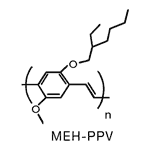Electronic Properties of Molecules Used for Opto-electronic Devices
- Electronic Properties of Molecules Used for Opto-electronic Devices
- Fluorescence Microscopy of Organic Semi-conducting Materials: From Single Molecules to Aggregates
- RNA Splicing at the Single Molecule Level
- Single-Molecule Studies of Heterogeneous Solvation in Ionic Liquids
- Energy transfer in DNA-based dye arrays


Simplified structure of an OLED
We measure several fundamental electronic properties of molecules such as charge transfer and electronic delocalization using a technique known as Stark spectroscopy. These measurements involve applying large electric fields to molecules in films or matrices and analyzing the effects of the field perturbation on the absorption or emission spectrum. Through these measurements, we pursue an understanding of how conformation and the environment, be it a protein, glass, polymer, or solvent, affects a molecule's fundamental electronic properties. Equally important is how molecules interact with one another to form aggregate species having unique optical and non-linear optical properties, an area we are currently exploring. In collaboration with Dr. David Yaron, we have also exploited the interplay between computational chemistry and our experimental results to better understand the detailed interactions between molecules and their surroundings. In this area, we have recently focused on the properties of MEH-PPV and other molecules used to make to organic light emitting diode devices (OLEDs) and organic photovoltaic solar cells (OPVs). Stark spectroscopy not only allows us to determine how electronic delocalization may be enhanced by aggregation but also allows us to study the mechanism by which an applied electric field, such as those present in organic devices, can dissociate the excited state to produce free charges. In OLEDs, this process leads to emission quenching which is detrimental to device efficiency. However, as field-induced dissociation is the mechanism by which OPVs convert light to electricity, this process is important to the overall efficiency of the device.